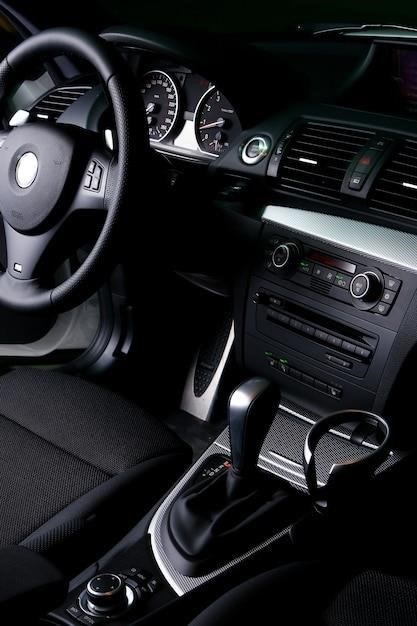BMW 335i Manual Transmission⁚ A Deep Dive
This in-depth exploration delves into the nuances of the BMW 335i’s manual transmission. We examine its performance, reliability, modifications, and comparisons to automatic counterparts, highlighting the driving experience and market value of this sought-after combination.
Performance and Driving Experience
The BMW 335i with a manual transmission offers a unique and engaging driving experience, often praised for its balance of performance and driver involvement. The combination of the potent N54 twin-turbocharged inline-six engine and the precise six-speed manual gearbox delivers exhilarating acceleration and responsive handling. Many enthusiasts appreciate the direct connection to the car provided by the manual, allowing for precise control over gear selection and engine speed. The precise shift throws and relatively light clutch contribute to a smooth and enjoyable driving experience, even in city driving conditions. While some sources suggest a slight performance deficit compared to the automatic in terms of 0-60 times, the manual transmission’s involvement more than compensates for this in the eyes of many drivers. The ability to precisely manage engine braking and smoothly execute downshifts adds to the overall dynamic appeal of the 335i manual. This makes it a favorite among driving enthusiasts who value the tactile feedback and control afforded by a manual gearbox.
Fuel Economy and Real-World MPG
Fuel economy in the BMW 335i manual transmission, while not its strongest suit, is a factor to consider. Official EPA figures often cite estimates around 17-18 mpg city and 24-26 mpg highway. However, real-world fuel economy can vary significantly depending on driving style, conditions, and vehicle maintenance. Aggressive driving, frequent acceleration, and heavy use of the air conditioning will noticeably decrease fuel efficiency. Conversely, a gentle driving style and consistent highway cruising can improve real-world MPG. The weight of the vehicle and the power of the turbocharged engine inherently impact fuel consumption. While some drivers report achieving figures closer to the EPA estimates, others find that their actual MPG falls significantly below. Factors like tire pressure, terrain, and even the condition of the engine all play a role. Ultimately, the 335i’s fuel economy is a trade-off for its performance capabilities. Those prioritizing fuel efficiency should explore other vehicle options; however, for performance enthusiasts, the trade-off is often considered acceptable.

Reliability and Common Issues
The reliability of the BMW 335i with a manual transmission, like many performance vehicles, is a complex issue. While the robust nature of the N54 engine is often lauded, potential problems exist. Reports suggest that the high-performance nature of the engine, coupled with the demands of a manual transmission, can lead to increased wear and tear. Clutch issues, including premature wear or slipping, are a concern for some owners, especially those with aggressive driving styles. The manual transmission itself, while generally considered well-engineered, is not immune to problems; synchromesh issues have been reported in some cases. Furthermore, the turbochargers, a key component of the N54 engine, can sometimes experience issues, and maintaining the high-pressure fuel system is crucial. Regular maintenance, including timely oil changes and careful monitoring of fluid levels, is vital for extending the lifespan of the components. Owners should be aware that repairs for certain parts can be expensive, further emphasizing the importance of preventive maintenance. Ultimately, the 335i’s reliability depends heavily on the owner’s diligence in upkeep and driving habits. Diligent maintenance and a moderate driving style can significantly improve the longevity of this powerful machine.
Modifications and Upgrades
Enthusiasts often seek to enhance the BMW 335i manual’s performance through modifications. Upgrades range from simple bolt-on parts to extensive engine rebuilds. Popular modifications include performance intakes and exhaust systems to increase airflow and optimize engine breathing. Upgraded intercoolers are also common, improving cooling efficiency and reducing intake air temperatures under high loads. Software tuning (such as ECU remapping) can significantly boost power and torque output, but carries risks if not professionally done. For those seeking improved handling, suspension upgrades like coilovers and stiffer sway bars are popular choices, enhancing responsiveness and reducing body roll; Upgrading the braking system with larger rotors and performance pads is another frequent modification to improve stopping power. While some modifications are relatively straightforward, others, such as turbocharger upgrades, require significant mechanical expertise. It’s essential to research thoroughly and choose reputable parts suppliers and installers to ensure compatibility and avoid potential complications. Improper modifications can void warranties and potentially damage the vehicle, highlighting the need for careful planning and execution.
Clutch and Gearshift Feel
The BMW 335i manual transmission is praised for its engaging driving experience, often described as “forgiving” even for novice drivers. The clutch engagement point is typically smooth and predictable, allowing for precise control. Many owners appreciate the relatively light clutch pedal effort, which reduces fatigue during prolonged driving. The gearshift is characterized by short, positive throws, making for quick and accurate changes. The shift mechanism’s precision contributes to the car’s sporty feel, rewarding drivers with a satisfying mechanical connection. However, subjective experiences vary, with some reporting a slightly notchy feel in certain gears, potentially influenced by factors such as age, mileage, and driving style. While generally considered a positive aspect, the clutch’s forgiving nature may not appeal to all drivers, particularly those accustomed to heavier or more aggressive clutch engagement. The precise feel of the gearshift, while appreciated by many, could be perceived as overly firm by others who prefer a smoother, less direct shifting action. These nuances highlight the importance of test-driving a 335i manual before purchasing to ensure the clutch and gearshift characteristics meet individual preferences;
Comparison to Automatic Transmissions
The BMW 335i offers both manual and automatic transmission options, each with distinct advantages. While the automatic, particularly the ZF 8-speed, provides convenience and smooth shifting, the manual transmission delivers a more engaging and driver-centric experience. The manual allows for complete control over gear selection, enabling drivers to optimize performance for specific driving conditions or maximize the thrill of driving. The automatic transmission, however, prioritizes ease of use, making it ideal for daily commuting or less spirited driving. Many enthusiasts prefer the manual for its direct connection to the powertrain, offering a more visceral and rewarding driving feel. Conversely, the automatic’s seamless shifts and lack of manual input may be preferred by drivers prioritizing comfort and fuel efficiency. The choice between manual and automatic often comes down to personal preference; those seeking a performance-oriented and engaging driving experience generally favor the manual, while those who prioritize ease of use and fuel efficiency often opt for the automatic. Ultimately, the ideal transmission depends on individual driving style and priorities.
Manual Transmission Availability and Market Value
Finding a Used 335i Manual
Locating a used BMW 335i with a manual transmission requires diligent searching and a bit of patience. Due to the decreasing popularity of manual transmissions, the number of used 335i models available with this option is considerably lower than those equipped with automatic transmissions. Online marketplaces like eBay and specialized automotive websites focusing on used luxury cars are excellent starting points. Expanding your search radius geographically may broaden your options. Thoroughly inspecting any potential purchase is crucial. Check for any signs of excessive wear and tear on the clutch, transmission, and other components. A pre-purchase inspection by a trusted mechanic specializing in BMW vehicles is highly recommended to identify any potential mechanical issues before committing to a purchase. Remember to compare prices across different listings to ensure you’re getting a fair deal, bearing in mind the premium value often associated with the manual transmission variant. Patience and persistence will increase your chances of finding a well-maintained, fairly-priced used BMW 335i manual.

Maintenance and Repair Costs
Maintaining and repairing a BMW 335i, especially one with a manual transmission, can be more expensive than maintaining average vehicles. The complexity of the turbocharged engine and the specialized components involved in the manual transmission system contribute to higher repair costs. Routine maintenance, such as oil changes, filter replacements, and brake pad replacements, will still be necessary and should be performed according to the manufacturer’s recommended schedule. However, more significant repairs, like transmission work or turbocharger issues, can be substantial. Finding a reputable mechanic specializing in BMW vehicles is essential to minimize costs and ensure quality repairs. Using genuine BMW parts is recommended, but using high-quality aftermarket parts can sometimes offer cost savings while maintaining acceptable performance. Factor in potential costs for specialized tools and expertise needed for certain repairs. Regular preventative maintenance, such as timely oil changes and careful driving habits, can help extend the life of the components and potentially reduce long-term repair costs. Researching parts pricing before undertaking repairs allows for better budgeting and comparison shopping.